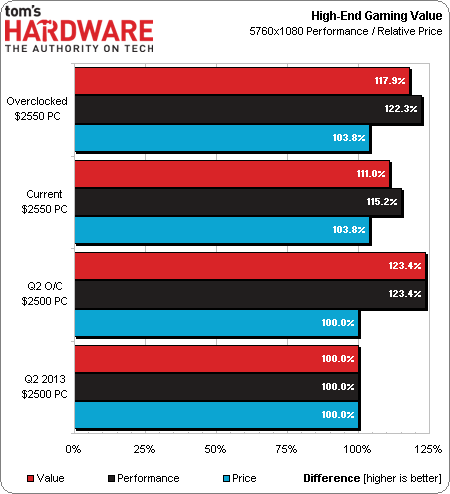System Builder Marathon, Q3 2013: $2550 Performance PC
Is Our Three-Way SLI-Based Setup Efficient? Can We Even Talk Value?
The concept behind this quarter’s high-end build was to use a larger ATX form factor to improve upon the previous machine in as many ways as possible, for the same money. Recently-expired discounts have pushed its price nearly 4% higher than when we placed our order, though new and remaining discounts should still make the machine a great overall value. For those who pay their own electric bills, efficiency is probably a greater disappointment than the price difference. Fortunately, we see some hope in a newer Ivy Bridge-E-based Core i7-4930K, manufactured on Intel's 22 nm node.
Sandy Bridge-E has always been a power hog, and a trio of graphics cards typically consumes more power than one dual-GPU card. Yet, I’m still surprised by the enormity of power consumption differences. Maybe I shouldn’t have been?
Remembering that the new machine was tested with Intel's slower RSTe storage driver in stock trim, and the faster Microsoft driver when overclocked, I ran an experiment with the stock configuration. The 20% gain from overclocking drops to around 15% when the new machine is tested at stock frequencies, but complemented by Microsoft's driver. Moreover, its stock-to-stock value rating jumps from 99.4% to 104.6%. Since the previous build lacked support for RSTe altogether, this quarter's effort becomes a better value at stock settings than its predecessor.
Overclocking is a different story. The previous machine was a supreme overclocker in spite of its small size, thanks to an elaborately-planned cooling system that made it the biggest mini-ITX machine we’d ever seen. The new build didn't overclock well at all. Part of this was the fault of a surprisingly-hot CPU, which somewhat soured our opinion of Sandy Bridge-E. Moreover, ASRock’s X79 Extreme6 didn't fare as well as we were hoping it would. I almost wish I paid $15 more for the lower-end Extreme4 and used a cheaper case to make up the price difference. There are good reasons why the X79 Extreme4 won a Tom's Hardware award and the Extreme6 did not.
And then there’s gaming. Overclocking provided the previous build a huge boost in average frames per second, while the current build barely sped up at all. If you don't overclock, you're going to love the 15% performance advantage at stock clock rates, while overclockers will be disappointed to further that advantage by a mere 7%. The previous build’s excellent overclock wins in spite of a far smaller form factor.
Current page: Is Our Three-Way SLI-Based Setup Efficient? Can We Even Talk Value?
Prev Page Power, Heat, And Overall PerformanceGet Tom's Hardware's best news and in-depth reviews, straight to your inbox.
-
rolli59 Nice one I got surprised, Tri SLI! I can see why editors wanted to try it knowing that the GTX770 is just an power efficient and overclocked GTX680.Reply -
slomo4sho The gaming benchmarks are surprisingly disappointing. Maybe going with a 3770K/4770k with three 7970 or 770 may have provides better results.Reply -
Crashman Reply
Not sure about decimating, but it would have cost a little more and not filled Paul's curiosity. IIRC, the 760 4GB's were around $20 cheaper on order day.11596966 said:3x7970's would decimate this build for the same amount of money...
On the other hand, Paul's single GPU was OK with 2GB. I figured we'd need a jump to 4GB with 3-way on his GPU, but 3GB on the 7970 probably would have been enough. Also, a total difference of $60 still would have fit within the budget limit, so, maybe Ivy-Bridge E and Radeons for the next build?
In order to prove what you're saying, I would have needed to search for worse-performing overpriced parts. You'll see on Day 4 that this build has the best performance of the three. So this build actually doesn't prove anything, except maybe that six core processors boost six-core benchmarks and that more graphics power gives you better frame rates at 5760x1080 (etc). But we didn't actually need any proof for those things, did we?11597019 said:This build proves that spending the most money does not equal to best performance. -
lp231 This build proves that spending the most money does not equal to best performance. It's all about balance and most of the time, it's getting 2 or more graphic cards that drives these systems pass the $2K mark. If I had $2550 to spend on a build, I know that half of the $2550 won't be going towards 3 graphic cards.Reply -
slomo4sho Reply11596998 said:Maybe Ivy-Bridge E and Radeons for the next build?
Tom, the future builds need to have better budget tiers. The doubling of the funds in each tier is fine in certain cases but it doesn't provide real insight into hardware choices. Having the tiers with a fixed figure increase such as a $250-400 increase in budget per tier would make more sense. Also, I would love to see the comeback of the $500 budget builds.
Lastly, what happen to the idea of themes each quarter? -
CaptainTom ^ Check the prices. A 7970 is the same price as the 4GB 760's. A 7970 is 20% faster than the a 760 and that lead grows at higher resolutions. Just look at how 3x7970's gain on 3xTitans...Reply -
CaptainTom ^ Check the prices. A 7970 is the same price as the 4GB 760's. A 7970 is 20% faster than the a 760 and that lead grows at higher resolutions. Just look at how 3x7970's gain on 3xTitans...Reply -
Yargnit I'm assuming going with Nvida as opposed to AMD video cards had to do with AMD not fully supporting frame-pacing across multiple monitors and all settings. Thus with 3-way video cards they wanted to go with what would provide the smoothest experience.Reply




